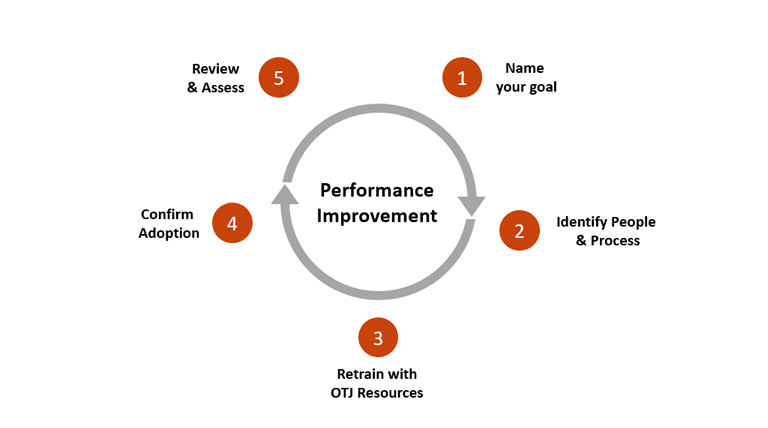Create Relevant Resources for Frontline Teams
Make rapid progress against your goals by putting yourself in the shoes of your frontline workers
- The performance of our frontline employees determines our success.
- Highly dense and jargony documents aren’t helpful to our frontline employees.
- We can develop resources for our employees that make it easy for them to work independently and get us to positive results faster and more efficiently.

In 1984, Nike revolutionized the sneaker industry with the release of its Air Jordan line. Over the next 40 years, the Jordan Brand would become so popular that it continues to generate $3 billion in annual revenue for the company.1
The Air Jordan’s popularity was obviously tied directly to the success of Jordan himself. But it would never have taken off if he hadn’t worn them while smashing records and leading the league in scoring for ten seasons. So, the shoe couldn’t just be stylish it had to perform. Jordan himself contributed to the design, specifying a low sole that “allowed him to feel the court beneath his feet.”2
The concept of designing athletic shoes specific to their celebrity namesake has evolved over time, becoming even more aligned to the players’ individual needs. The Converse Wade 1, for example, offers “fit, stability, and flexibility; very good foot support, cushioning, traction, and responsiveness; with moderate grip and breathability, a shoe designed for guard play” – a must for its namesake Dwayne Wade.3
At work, our frontline employees are our star athletes. Their performance determines our success.
Today, we’re tackling as many as five types of complex initiatives at the same time — each of which can involve five to eight corporate functions, like safety, quality, maintenance, etc.4 And the outcome of every project, big or small, depends on frontline employees’ ability to perform the work.
As leaders, our top priority should be to make it easy for our teams to work independently while following our One Best Way procedures. By putting ourselves in the shoes of the frontline worker, we can develop resources that get us to positive results faster and more efficiently.
Stepping out of our most comfortable shoes

When developing resources for frontline employees, we each tend to look at the task from the perspective of our functional area5 – operations, safety, quality, maintenance, etc.
We’re thinking about the regulatory requirements we need to comply with. We’re thinking about our departmental goals and obligations. We’re thinking about how we’ll be personally impacted in the event of an incident we could have prevented.
Our natural tendency is to cover all those bases as thoroughly as we can through training and resources that meet our specialized needs. We build highly specific documents with jargony language that map to oversight needs. We develop hours-long training curricula to ensure we’ve prepared for every scenario.
In the end, we’ve created dense policy and procedural material that’s only loosely connected to our near-term business objectives. What’s worse is we often store the information in specialized platforms designed for our knowledge domains and teach it in classrooms away from the work environment.
For our non-expert frontline employees, none of this is super helpful. It’s difficult to access, challenging to remember, and disconnected from day-to-day work.
Stepping into the shoes of our frontline employees

If you really want to move the needle on this quarter’s most challenging goal, think about how you’ll change the dynamic on the frontline. Here’s a process you can follow to develop and execute a plan:

1) Name your Goal
What’s the improvement you want to make and the metric you’ll use to track it? Don’t try to boil the ocean. Concentrate on the thing that’s most important and branch out from there.
2) Identify Process & People
What operational changes will you make and who needs to change the way they work? Don’t focus on all processes, just the ones involved in your initiative. Engage your team to understand specifically how their day-to-day activities will change.
3) Retrain with OTJ Resources
What resources will help guide your team to do things the new way? The more relevant your tools are, the faster your team will adapt and begin to work independently.
4) Confirm Adoption
How will you know if your team is actually following your new procedures? Make sure employees understand the change, and make sure they know it’s their responsibility to follow it.
5) Review & Assess
How will you know if you’ve met your goal? Monitor incremental progress against your metric in step 1. You’ll know pretty quickly if you’re on the right path or more changes are needed.
Approaching your project from this perspective will help make it more successful and will get you to your preferred result faster. It will likely have the added benefit of making life better for your frontline teams.
Lessons learned from walking in our clients’ shoes

We’ve helped our clients deploy Acadia as the enabling platform to make rapid progress against aggressive goals. Here are a few that stand out.
Complex roles span operational silos
The role of frontline operators has changed significantly over time for one of our largest manufacturing clients. Previously, employees could become experts in a single specialty over the course of many years. Now, with fewer employees working a line, operators need to become proficient at a wide range of skills in just a few months.
The company makes it work by providing access to digital work instructions that support operators through every step. Simple safety, maintenance, and quality tasks are incorporated as part of workflow. Other more complex troubleshooting and reaction plans are just a click away.
Deploying operator-centric resources has led to faster time to proficiency for new hires, as well as improvements across multiple operational metrics.
Improving one process at a time
A common procedure for one of our clients requires planned downtime 20-30 times per day at each of their facilities. At one of their largest facilities, it happens up to 60 times per day.
Continuous improvement managers at one plant deployed work instructions for an improved process in Acadia. Each team member was required to read and acknowledge the proper preparation and execution of the procedure. Then, they were quizzed on the information. Finally, they were observed and formally evaluated executing the procedure live. Individual progress was tracked in Acadia to identify team members who needed additional support and to capture feedback from team members to improve the process further.
After just two weeks of training and operating using the new method, the team had already improved their unplanned downtime by 19% and reduced product waste. When implemented across all plants producing the same products, the savings will be in the millions of dollars.
Supporting frontline employees in the back office
A client that grew through M&A activity had competing quoting, billing, and collection processes making rework commonplace in its order to cash process.
Acadia became the single source of truth for operational SOPs, job aids, and policies, removing confusion for frontline team members on the sales and finance teams.
The company has since reduced errors by ensuring orders are sold, delivered, and billed consistently and accurately. More importantly, they’ve created a unified customer experience across all touch points.
Finding the right fit for you
Results like these are just the tip of the iceberg. When you put your frontline employees at the center of your plan, you’ll see rapid improvement – and happy employees! If you’re working on a project this quarter and don’t know where to start, give us a call. We’ll help you think through it.
Sources:
Ready to crush your goals?
"*" indicates required fields


